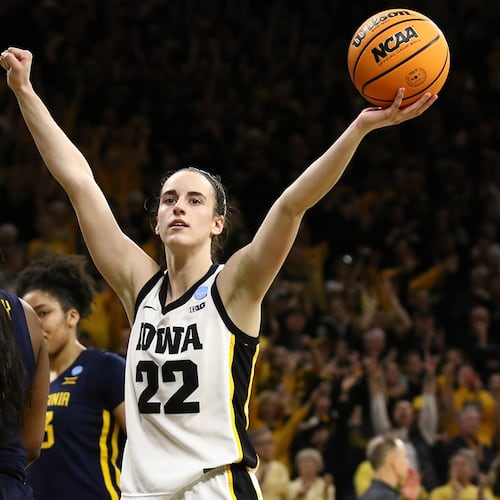Yesterday’s missive addressed local college hoops, the state of which remains unchanged: Georgia State is pretty good; Georgia Tech is sub-.500 and Georgia under Tom Crean is 3-22 in SEC play. If we survey the basketball being played in the other 49 states, we find something approaching anarchy.
The Final Four will be played at Mercedes-Benz Stadium. This we know. That is, however, about all we know. The Final Four could be anything. Were the pairings set today, the top four seeds might well be Baylor, Gonzaga, Kansas and San Diego State — all based on the far side of the mighty Mississippi. Since the NCAA tournament began seeding in 1979, there has only been one edition to feature three No. 1 seeds tilted that far westward, that in 2003.
Last year’s event had three No. 1s from the ACC. If these projected 1s hold — they won’t, but play along — the Big 12 will be the only Power 5 conference represented. The regular season, which still has five weeks to run, has seen seven different teams ranked No. 1 in the Associated Press poll. The latest is Baylor, which didn’t receive a vote in the preseason poll. Neither did San Diego State, the nation’s one remaining unbeaten. Four of this week’s top seven — those two plus Florida State and Dayton — didn’t crack the preseason Top 25.
Even before New Year’s, close observers of the sport had declared this the season of No Great Team. Asked about this after his latest Duke team won at Georgia Tech, Mike Krzyzewski didn’t quibble. Instead he pointed to a cause, and it wasn’t the one many identify as the root of all collegiate evil — the one-and-done. Quoth Coach K: “You know our sport had 1,000 transfers this year, right?”
There are 353 Division I programs. One thousand transfers would mean the average program saw 2.8 players exit not via graduation or to turn pro but because they wanted to play amateur ball elsewhere. In 2018, the latest year for which the NCAA has compiled data, the transfer rate for D-1 men’s basketball was a staggering 29.1 percent. (The 2018 transfer rate for FCS football was less than half that.)
It’s not just the best players that up and leave; the just-OK players do, too. Josh Pastner keeps saying that his goal for Georgia Tech is to “get old and stay old,” meaning having a roster laden with players who are both seasoned and familiar with one another. That’s a laudable aim, but who in college hoops can achieve that anymore?
Example: Kerry Blackshear. He made second-team all-ACC last season in helping lead Virginia Tech to the Sweet 16. Had he remained in Blacksburg, he’d have been the only member of the first and second all-conference teams to return. When coach Buzz Williams left for Texas A&M, Blackshear split, too. He’s now the leading scorer and rebounder for Florida. That’s not an indictment of anything. That’s just the way of the basketball world.
The upshot is that even the blueblood programs get stretched thin. This is the least gifted Duke team since the one that was upset by Mercer in 2014. This might be the second-worst Kentucky team since John Calipari arrived in Lexington in 2009. North Carolina, minus the injured freshman Cole Anthony, just had to win consecutive games to get to 10-10. UCLA is likewise 10-10. Those four programs have combined for 30 of the 81 NCAA championships.
We haven’t yet hit February, but we’ve seen enough to believe that, come March, the usual Madness could be replaced by chaos. Duke lost last week at Clemson, the same Clemson that had just won at North Carolina for the first time ever. In December, that same Clemson lost at home to Yale. If you’re looking for a down-bracket sleeper, look no further the Ivy League Bulldogs, who are 14-4 and whose losses have come by a total of 17 points. Yale has history in the NCAA tournament: It gave No. 3 seed LSU a run last year, and in 2016 it upset Baylor, now the nation’s No. 1.
College basketball has grown accustomed to subsisting without top-end talent, such talents having left for the NBA while still teenagers. But the scattering of mid-level talent, which has only accelerated with the advent of the transfer portal, is something everybody’s still trying to process.
Georgia, which could have the NBA’s No. 1 draft pick in Anthony Edwards, couldn’t hold a 20-point second-half lead at Missouri on Tuesday. Kansas would get some backing as the nation’s most talented team, but the Jayhawks could manage only 55 points in a home loss to Baylor, whose MVP might be big man Freddie Gillespie, who began his collegiate journey at Division III Carleton College.
Rutgers hadn’t broken .500 since 2004, when it was in the old Big East, and its first five seasons in the Big Ten saw it go 16-76 in league play. The Scarlet Knights hold third place in the Big Ten and are ranked 25th in the AP poll. Their best 3-point shooter is Akwasi Yeboah, who this time last year was the leading scorer for the Stony Brook Seawolves of the American East. And on it goes.
Come April, it will all stop here. It’s possible we could have a Final Four of usual suspects — Kansas, Kentucky, Duke, Michigan State. (Not North Carolina, though.) But in a season where form has been cast to the winds, that seems unlikely. I could envision something like Rutgers, Yale, San Diego State and Dayton, with Obi Toppin and the Flyers cutting the nets. And with Kevin Riley, who’s the editor of the AJC and a Dayton grad, taking victory laps.
About the Author
The Latest
Featured


